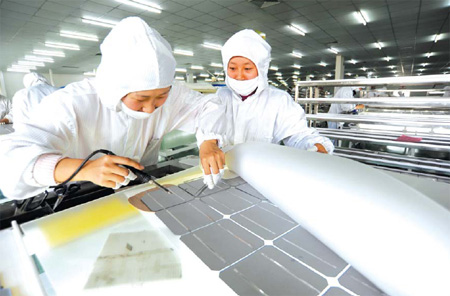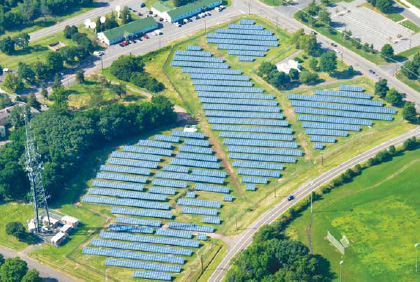Economy
Rise and shine
Updated: 2011-03-25 13:08
By Meng Jing (China Daily European Weekly)
Dezhou city,
Shandong province
Dezhou, a small city in Shandong province, has no airport or port.
So it may come as a shock to most people that the third-tier city in East China was the host for the 4th International Solar Cities World Congress in September 2010 while its predecessors were renowned cities including Oxford in the United Kingdom.
|
 Workers assemble solar panels at a factory in Jiangsu province, where about 700 companies are involved in the solar sector. Xu Jinbai / for China Daily |
But once you step into Dezhou, you will find cutting-edge solar power devices everywhere, from traffic lights to rooftops. Nearly 10,000 solar road lamps have been installed in 50 main streets and 20 residential communities in Dezhou, which help save 952 tons of coal annually, says Li Yanhua, head of the publicity department of Dezhou city government.
About half of the number of households in the city also uses solar water heaters. The number is 95 percent when it comes to newly constructed buildings, she says.
Himin Solar, a leading company in China's solar thermal industry, has a major stake in Dezhou's solar achievements.
Himin has been pioneering China's solar thermal industry since its establishment in 1995. The company produced 16 percent of the solar water heaters in the Chinese market by 2005. It sells 300 million square meters of solar water heaters annually, which equals the total amount produced in the European Union and is twice that of North America, the company says.
|
 An array of 7,600 solar panels produced by Yingli converts sunlight into electricity on the Livingston Campus of Rutgers University in New Brunswick in the US. |
The rapid growth of Himin Solar has fueled the development of the solar industry in Dezhou, which was once a farming area without any pillar industry. Three out of 10 people in Dezhou work in solar energy-related sectors, which have an estimated size of 30 billion yuan (3.2 billion euros), generating 20 percent of the city's total GDP, Li says.
But Huang Ming, chairman of Himin Solar, says using solar water heaters alone is not the way to fight global warming.
"Energy-efficient buildings are the future. Cutting down greenhouse gases should be done in every aspect of people's daily life," Huang says.
Huang has spent billions of yuan on a pilot project to demonstrate his idea. About 40 energy-efficient buildings, including hotels and museums, have been built in Dezhou's solar valley, an industrial and tourist site where Himin
Solar is also based.
|
|
The energies used in the buildings come from solar collectors on the roof, and the hot water, cooling and heating systems are all solar-powered. All of the buildings on the site are designed to save at least 70 percent of the energy used in regular buildings.
Huang has also started to shift his company's focus from solar water heaters to real estate, by developing an energy-efficient residential community in Dezhou named Utopia Garden, which represents his idea of a sustainable, environmentally friendly lifestyle.
However, Meng Lihui, secretary-general of the environment management research center under Fudan University, says that Huang's energy-efficient buildings are bogged down by their high costs.
"An apartment sold in Utopia Garden is about 8,000 yuan per sq m, which is double the price of an average apartment in Dezhou," Meng says.
"Solar technology is also not fully developed yet. It still requires long-term research before it can maintain a stable performance," Meng says.
Meng, who is involved in drafting Dezhou's solar city development roadmap for 2009-2030, a local-government-level blueprint, says the most challenging part for Dezhou is the market.
Specials

In the swim
Out of every 10 swimsuits in the world, seven are made in China.

Big spenders
Travelers spend more on shopping than food, hotels, other expenses

Rise in super rich
Rising property prices and a fast-growing economy have been the key drivers.
